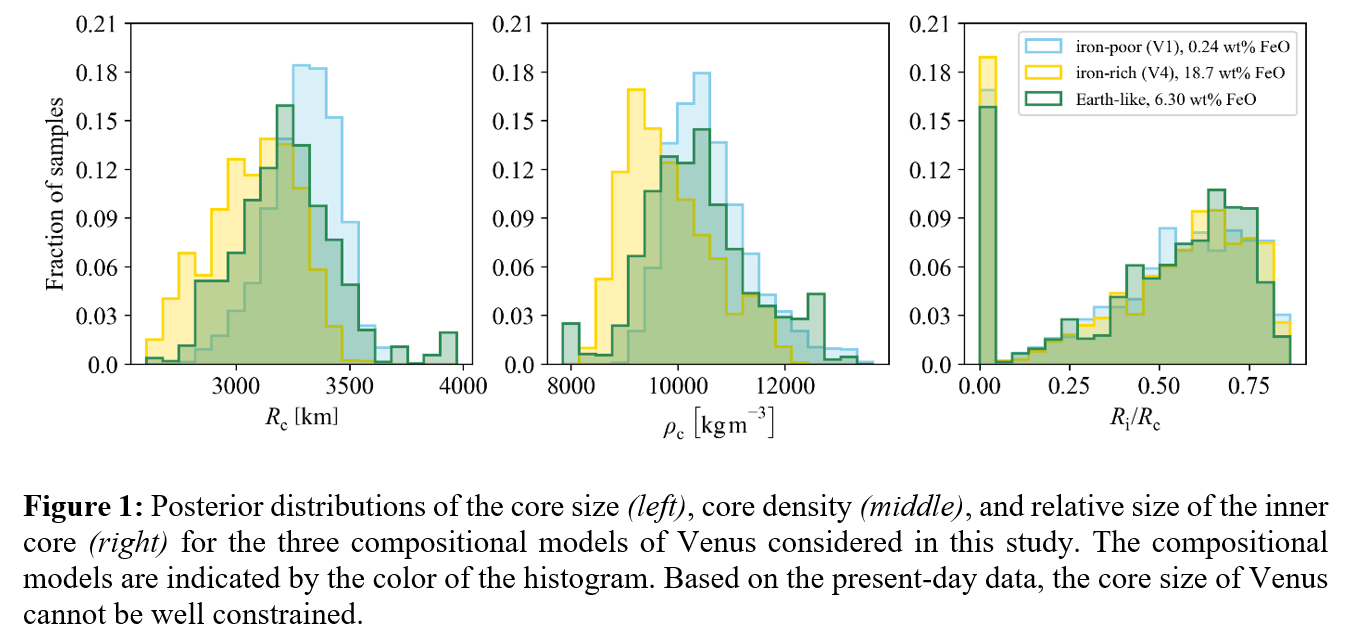Constraining the interior structure and thermal state of Venus
- 1Department of Geophysics, Faculty of Mathematics and Physics, Charles University, Prague, Czechia (kanovami@gmail.com)
- 2Institute of Planetary Research, German Aerospace Center (DLR), Berlin, Germany
- 3Department of Earth Sciences, Freie Universität Berlin, Berlin, Germany
- 4Jülich Supercomputing Center, Forschungszentrum Jülich (FZJ), Jülich, Germany
Often termed the twin sister of the Earth, Venus represents an alternative outcome of the evolutionary path taken by large terrestrial planets. Given its extreme surface conditions, lack of surface water, and the absence of plate tectonics, the present-day thermal state of its mantle is likely very different from the Earth. Venus also remains the most enigmatic of terrestrial worlds in terms of interior structure. Both its tidal Love number k2 and moment of inertia factor, the main sources of information on the core size and interior structure, are known with a large uncertainty of about 10% [1, 2], and the magnitude of tidal dissipation, sensitive to the planet’s thermal state, has only been determined indirectly [e.g., 3]. Yet, the set of observables acquired by the Magellan and Pioneer missions can still be used to put constraints on the interior structure.
In this study, we combine the calculation of global tidal deformation with a 1-d parameterised model of mantle convection in the stagnant-lid regime [4,5] and we perform a Bayesian inversion of several observational and theoretical constraints (such as the tidal Love number, maximum elastic thickness, or absence of intrinsic magnetic field) to gain insight into the present-day interior structure and thermal state of Venus. The convection model is based on the thermal boundary layer theory and incorporates partial melting, crustal growth, and inner core crystallization. The elastic structure of the mantle for three selected mineralogical models is obtained from the software Perple_X, based on the minimisation of Gibbs free energy [6]. Lastly, to find the tidal parameters, we calculate the tidal deformation of a layered compressible viscoelastic sphere, using the formalism of the normal mode theory [7]. The mantle is described as governed by the Andrade rheological model, which has proven essential for distinguishing between a fully solid and a fully or partially liquid Venusian core [8].
We vary a large set of rheological, structural, and thermodynamic parameters and predict a range of mantle temperatures consistent with previous stagnant-lid models, average mantle viscosities between 1020-1022 Pa.s, and tidal quality factor Q=48+84-22. Specifically, the mean value of the tidal quality factor, a parameter inversely proportional to the rate of tidal dissipation, is close to the values derived from studies of equilibrium between solid-body and atmospheric tides [3]. We also investigate the effect of assumed mantle composition on the predicted core size and density and address the question of how likely is the existence of a fully solid or fully liquid core (Figure 1). Finally, we discuss the improvements in data expected from future missions VERITAS and EnVision.

References
[1] Konopliv & Yoder (1995), GRL, 23(14):1857-1860, doi:10.1029/96GL01589.
[2] Margot et al. (2021), Nat. Astron., 5:676-683, doi:10.1038/s41550-021-01339-7.
[3] Correia & Laskar (2003), Icarus, 163(1):24—45, doi:10.1016/S0019-1035(03)00043-5.
[4] Morschhauser, Grott, & Breuer (2011), Icarus, 212(2):541-558, doi:10.1016/j.icarus.2010.12.028.
[5] Baumeister et al. (2023), Astron. Astrophys., 675(A122):23, doi:10.1051/0004-6361/202245791.
[6] Connolly (2009), G3, 10:Q10014, doi:10.1029/2009GC002540.
[7] Takeuchi & Saito (1972), Methods in Computational Physics, 11:217-295, doi:10.1016/B978-0-12-460811-5.50010-6.
[8] Dumoulin et al. (2017), JGR: Planets, 112(6): 1338-1352, doi:10.1002/2016JE005249.
How to cite: Walterova, M., Plesa, A.-C., Baumeister, P., Rückriemen-Bez, T., Wagner, F. W., and Breuer, D.: Constraining the interior structure and thermal state of Venus, Europlanet Science Congress 2024, Berlin, Germany, 8–13 Sep 2024, EPSC2024-214, https://doi.org/10.5194/epsc2024-214, 2024.